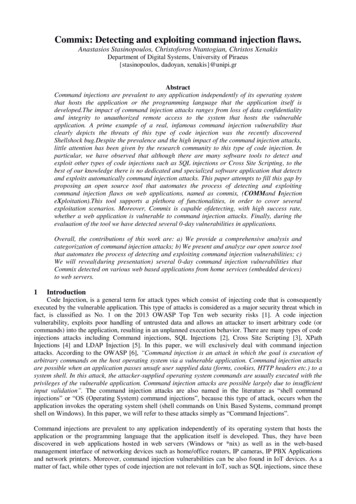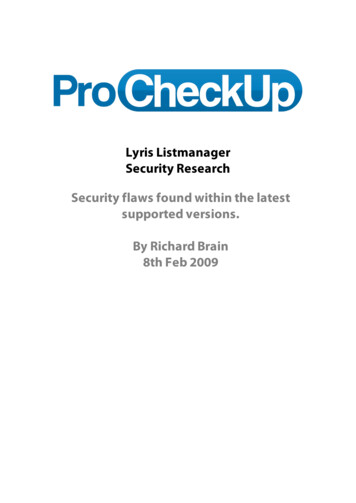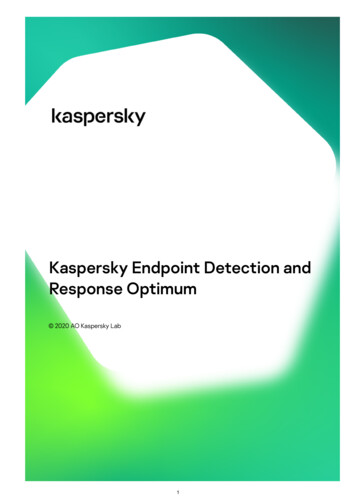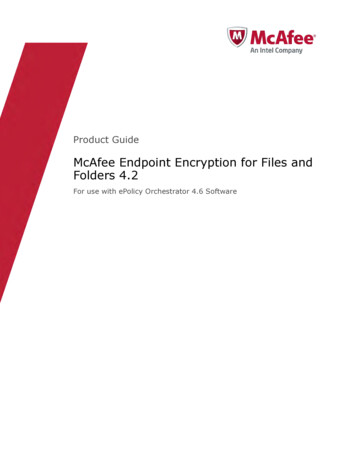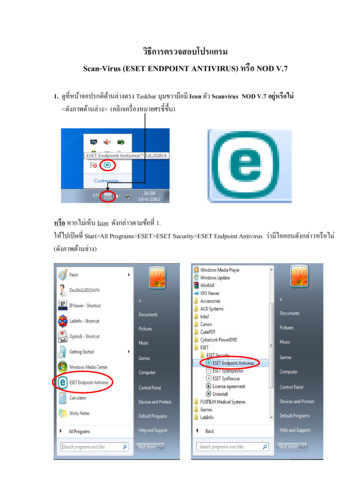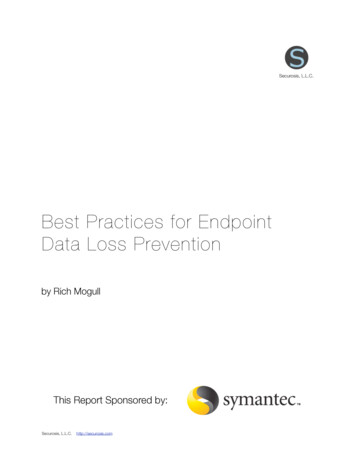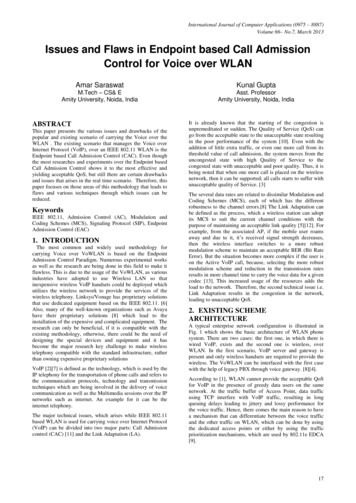
Transcription
International Journal of Computer Applications (0975 – 8887)Volume 66– No.7, March 2013Issues and Flaws in Endpoint based Call AdmissionControl for Voice over WLANAmar SaraswatKunal GuptaM.Tech – CS& EAmity University, Noida, IndiaAsst. ProfessorAmity University, Noida, IndiaABSTRACTThis paper presents the various issues and drawbacks of thepopular and existing scenario of carrying the Voice over theWLAN . The existing scenario that manages the Voice overInternet Protocol (VoIP), over an IEEE 802.11 WLAN is theEndpoint based Call Admission Control (CAC). Even thoughthe most researches and experiments over the Endpoint basedCall Admission Control shows it to the most effective andyielding acceptable QoS, but still there are certain drawbacksand issues that arises in the real time scenario. Therefore, thispaper focuses on those areas of this methodology that leads toflaws and various techniques through which issues can bereduced.KeywordsIEEE 802.11, Admission Control (AC), Modulation andCoding Schemes (MCS), Signaling Protocol (SIP), EndpointAdmission Control (EAC)1. INTRODUCTIONThe most common and widely used methodology forcarrying Voice over VoWLAN is based on the EndpointAdmission Control Paradigm. Numerous experimental worksas well as the research are being done in this field to make itflawless. This is due to the usage of the VoWLAN, as variousindustries have adopted to use Wireless LAN so thatinexpensive wireless VoIP handsets could be deployed whichutilizes the wireless network to provide the services of thewireless telephony. Linksys/Vonage has proprietary solutionsthat use dedicated equipment based on the IEEE 802.11. [6]Also, many of the well-known organizations such as Avayahave their proprietary solutions [8] which lead to theinstallation of the expensive and complicated equipment. Theresearch can only be beneficial, if it is compatible with theexisting methodology, otherwise, there could be the need ofdesigning the special devices and equipment and it hasbecome the major research key challenge to make wirelesstelephony compatible with the standard infrastructure, ratherthan owning expensive proprietary solutionsVoIP [2][7] is defined as the technology, which is used by theIP telephony for the transportation of phone calls and refers tothe communication protocols, technology and transmissiontechniques which are being involved in the delivery of voicecommunication as well as the Multimedia sessions over the IPnetworks such as internet. An example for it can be theinternet telephony.The major technical issues, which arises while IEEE 802.11based WLAN is used for carrying voice over Internet Protocol(VoIP) can be divided into two major parts: Call Admissioncontrol (CAC) [11] and the Link Adaptation (LA).It is already known that the starting of the congestion isunpremeditated or sudden. The Quality of Service (QoS) cango from the acceptable state to the unacceptable state resultingin the poor performance of the system [10]. Even with theaddition of little extra traffic, or even one more call from itsthreshold value of call admission, the system moves from theuncongested state with high Quality of Service to thecongested state with unacceptable and poor quality. Thus, it isbeing noted that when one more call is placed on the wirelessnetwork, then it can be supported; all calls starts to suffer withunacceptable quality of Service. [3]The several data rates are related to dissimilar Modulation andCoding Schemes (MCS), each of which has the differentrobustness to the channel errors.[8] The Link Adaptation canbe defined as the process, which a wireless station can adoptits MCS to suit the current channel conditions with thepurpose of maintaining an acceptable link quality [5][12]. Forexample, from the associated AP, if the mobile user roamsaway and due to it, it’s received signal strength decreases,then the wireless interface switches to a more robustmodulation scheme to maintain an acceptable BER (Bit RateError). But the situation becomes more complex if the user ison the Active VoIP call, because, selecting the more robustmodulation scheme and reduction in the transmission ratesresults in more channel time to carry the voice data for a givencodec [13]. This increased usage of the resources adds theload to the network. Therefore, the second technical issue i.e.Link Adaptation results in the congestion in the network,leading to unacceptable QoS.2. EXISTING SCHEMEARCHITECTUREA typical enterprise network configuration is illustrated inFig. 1 which shows the basic architecture of WLAN phonesystem. There are two cases: the first one, in which there iswired VoIP, exists and the second one is wireless, overWLAN. In the first scenario, VoIP server and gateway ispresent and only wireless handsets are required to provide thewireless. The VoWLAN can be interfaced with the first casewith the help of legacy PBX through voice gateway. [8][4].According to [1], WLAN cannot provide the acceptable QoSfor VoIP in the presence of greedy data users on the samenetwork. At the traffic buffer of Access Point, data trafficusing TCP interfere with VoIP traffic, resulting in longqueuing delays leading to jittery and lossy performance forthe voice traffic. Hence, there comes the main reason to havea mechanism that can differentiate between the voice trafficand the other traffic on WLAN, which can be done by usingthe dedicated access points or either by using the trafficprioritization mechanisms, which are used by 802.11e EDCA[9].17
International Journal of Computer Applications (0975 – 8887)Volume 66– No.7, March 2013Fig 1: System architecture diagram for a WLAN phone system3. ENDPOINTBASEDCALLADMISSION CONTROL FOR VOICEOVER WLANWhen it comes to define the Endpoint Admission Control(EAC) paradigm [3], it is a mechanism where the endpoint,such as the WLAN terminals sends the probe packets todetermine the state of the network i. e. whether the network isin the situation to admit a new call or not with acceptableQoS. Because as accepting even a single call above itsthreshold limit could result in the poor performance, it iscritical to determine that the call can be admitted or not.One more key fact of using the Endpoint Admission ControlParadigm is that there is no need to change the existingsystems and equipment. Components such as Access Pointsand routers can be effectively adopted without any changes inthem. Only requirement is the addition of wireless VoIPhandsets with their updated software.Depending upon the state of the network, in EAC, routersmark or drop the packets so that it is know that a call can beadmitted in network or not. The Marking is usually based onthe setting special Explicit Congestion Notification bits (ECNBits). The congestion information detected by the routers inthe duration when the probing is done, is being conveyed tothe endpoints and upon receiving the probes, the destinationendpoint echoes the probe packet back to the source endpoint.Then, at last, the information carried out is being used toperform the Call Admission Control (CAC) decisions [14].Referring to Fig. 2, the endpoint based call admission is basedon the ICMP echo messages which are being used to measurethe Round Trip Time (RTT), packet loss and Jitter. The probepackets are being used which mimic the traffic into factors:packet interval and packet size. The core motive to use theICMP echo message is this that all type of VoIP servers canrespond to them, without any reforms. In EAC, the echorequest mimic the uplink call leg and the echo reply mimic thedownlink call leg. The call is then admitted if the measuredRound trip Time (RTT), Jitter values are less than that of thethreshold limits. When call is being admitted, it enters intothe data phase where the VoIP packets are being transmittedover the WLAN. [4]Total three situations occur while using the endpoint basedcall admission control. These are:1.A call originates and also terminates on the WLANphone systems.2.A call originates but does not terminate on WLAN3.A call terminating only on the WLANThe first scenario takes place when the device L initiates thecall .Then the Endpoint based client on the handset send theprobe packet to the VoIP server to verify that the originatingcell is capable of supporting the call. If it is, the SIP INVITEmessage is send to the server to initiate the call setup. Now,after receiving the SIP invite message from the server, deviceM also sends the probe packets to the VoIP server to verifythat the terminating cell is also capable of supporting the call.In this case, if the call can be admitted, SIP (SignalingProtocol) completes the call setup procedure and thetransmission of the voice packets occurs with acceptableQuality of Service [15].If in case, the originating cell is not able to support the call,and then device L starts playing the busy tone. Then noINVITE message is being sent to M. If, in case, theterminating cell is unable to support the call, it sends the‘BUSY HERE’ message to device L via Server. Then deviceL plays the busy tone for its user.The second scenario, deals with the outgoing calls whichoriginated on the WLAN. Referring to the fig.1, this scenariocomes into the picture when there is call between L and N, Land O, and, L and P. In this, the originator sends the probepackets to the server and waits till the call is being admitted asshown in fig.3. Here one key fact to be noticed is this thatback to back probing is being done continuously which18
International Journal of Computer Applications (0975 – 8887)Volume 66– No.7, March 2013becomes the major drawback of this mechanism as describedfurther in this paper.SIP PhoneLSIP ProxySSIP Phone MProbe (ICMP Request)Probe (ICMP Response)Probe (ICMP Request)Admissionof CallProbe (ICMP Response)INVITEINVITE100 TRYINGProbe (ICMP Request)Probe (ICMP Response)Probe (ICMP Request)Probe (ICMP Response)180 RINGING180 RINGING200 OK200 OKAcknowledgementDevice M answersthe phoneAdmission of callRTP Voice SessionBYE200 OKFig 2: Sequence of Call Admission through ProbingThe third and the final scenario deals when the call existsbetween N and L, O and L, and, P and L. (refer fig. 1.). Here,when the callee receives the ‘SIP INVITE’ message, the clientprobes the server to verify if the terminating cell is capable ofsupporting the call. The process can be seen in fig. 2 belowthe dashed line.3.1 Algorithm of Endpoint Based CallAdmission ControlIt is appropriate to estimate the downlink delay through theRound trip time of the probe packets. As probes are sent bythe handsets, they have the fixed size and are sent at theregular interval. So, to track the Round Trip Time of the19
International Journal of Computer Applications (0975 – 8887)Volume 66– No.7, March 2013probes that are echoed back by the VoIP server, a window oflength twAC is being set in the VoIP enabled handsets.Fig 3: Call setup sequence when call terminates only onthe WLANAccording to [4], if NL probes are first transmitted into thenetwork. Then, if the next NAC probes transmitted have anaverage RTT delay greater than tvAC , the call is being rejectedelse this step is performed n times Thus, a call is eitherrejected after NL (c NAC) probes where 1 c n, oradmitted after NL (n NAC) probes.According to the existing scenario [4] [8], if a probe, is notreceived within the tvAC, is considered to be lost and thethreshold value is incremented by one. This is the majordrawback of this scenario as this algorithm could not specifythat is the probe being actually lost or it suffered from longRound Trip Time and the case treated as the ‘delay only’admission threshold This existing methodology does notprovide us the reason that what happened to the probe packetand if it is lost, the reason behind that is not known.Under the certain experimental conditions, it was being notedthat the system enters into three states: (Refer Fig: 4)1.Steady State: having lesser delay, jitter and no loss.2.Transient State: have increasing delays, highaverage jitter and no loss3.Steady State: have unacceptable high and constantdelay, low jitter and the periodic loss.These phases were distinguished when in experiment, theshortest transient period was measured as 1Mb/s lasting with36 packets and the longest transient period was noted as2Mb/s lasting with 120 packets.Referring to fig.5, in which Round Trip Time delays ofprobing the network has reached the quota because theprobing traffic pushed the WLAN capacity and the call wasrejected after the 19th probe packet.Fig 5: RTT delays seen by probes of a call which is notadmitted.4. ISSUES AND FLAWS:Apart from the certain advantages of the existing system suchas detecting congestion in the WLAN used by each party tothe call, using probe packets, there are certain issues and flawsin the existing scenario.While initiating the call, or call admission, the VoIP enabledhandsets sends the probe packets continuously till the call isaccepted for the admission into the network, which becomesthe major basis of causing the congestion into the network byflooding probe packets back to back.Most of the wireless devices such as the VoIP enabledhandsets work on the battery. Hence, sending the back to backprobe packets may drain their battery in the circumstanceswhen the client needs to wait for the call admission for thelengthier durationThese limitations could be fixed if special concern is beentaken of the lost probes in efficient way and by reducing theneed of back to back probing by using the retransmissiontimer. By using the retransmission timer, a time window ofcertain length could be set by which the time frame could beset by determining the average values. Then, instead of backto back probing, the client will send the probe packet and ifthe timer expires, it will send the other probe packet. If incase, the packet is being lost, the timer will expire and thenthe client will send the new probe. Therefore, by using theretransmission timer, the better results can be achieved in thereal time scenario by taking into consideration the thresholdvalue (measured by RTT), Retransmission timer interval, andthe time count along with other parameters.5. CONCLUSIONThe existing Endpoint based Call Admission control can beimproved by working on its limitations and flaws. It can beimproved by using the retransmission timer and so that theproblem of the congestion and the difficulties faced by theCall Admission in VoWLAN and the problems created byback to back probing could be reduced. By enhancing it bythis way, certain issues termed above can be fixed.6. ACKNOWLEDGMENTSFig 4: Various phases along with one way loss statisticsand delay in downlink direction when the system capacityis being exceeded.Sincere thanks to Mr. Kunal Gupta, for providing his valuableguidance in this field.20
International Journal of Computer Applications (0975 – 8887)Volume 66– No.7, March 20137. REFERENCES[1] W. Wang, S.C. Liew, and V.O.K. Li, “Solutions toPerformance Problems in VoIP over an 802.11 WirelessLAN,” IEEE Trans.[2] /sane2006/program/finalpapers/R3.pdf[3] K. Mase, Toward Scalable Admission Control for VoIPNetworks, IEEE Communications Magazine, Vol. 42,No. 7 July 2004.[4] Endpoint Admission Control for VoIPoWLAN PhilipMcGovern, Simon Chung, Seán Murphy and LiamMurphy[5] M. Lacage, M.H. Manshaei, and T. Turletti, “IEEE802.11 Rate Adaptation: A Practical Approach,” Proc.Seventh ACM Int’l. Symp. Modeling, Analysis andSimulation of Wireless and Mobile Systems, 2004[6] Is IEEE 802.11 ready for VoIP? Arlindo F. da Conceic ao, Jin Liy, Dinei A. Florˆencioy and Fabio i.pdf[7] pdfs/Hallock J VoIP Past.pdfMember, IEEE, Philip Perry, Member, IEEE, Sea nMurphy, Member, IEEE, and Liam Murphy, Member,IEEE.[9] Q. Ni, “Performance Analysis and Enhancements forIEEE 802.11e Wireless Networks,” IEEE Network, vol.19, no. 4, pp. 21-27, July/ Aug. 2005.[10] S. Garg and M. Kappes, .Can I add a VoIP call?,. IEEEICC 2003.[11] D. Gao and J. Cai, “Admission Control in IEEE 802.11eWireless LANs,” IEEE Network Magazine, Vol 19, No 4July/August 2005.[12] D. Qiao and S. Choi, “Fast-Responsive Link Adaptationfor IEEE 802.11 WLANs,” Proc. IEEE Int’l Conf.Comm. (ICC), 2005.[13] J. Pavon and S. Choi, “Link Adaptation Strategy forIEEE 802.11 WLAN via Received Signal StrengthMeasurement,” Proc. IEEE Int’l Conf. Comm. (ICC),May 2003.[14] S. Shin, H. Schulzrinne, “Call Admission Control inIEEE 802.11 WLANs Using QP-CAT,” Proc. IEEEINFOCOM, Apr. 2008.[15] ITU-T, “Recommendation P.800: Methods for SubjectiveDetermination of Transmission Quality”[8] Endpoint-Based Call Admission Control and ResourceManagement for VoWLAN by Philip McGovern,21
Linksys/Vonage has proprietary solutions that use dedicated equipment based on the IEEE 802.11. [6] Also, many of the well-known organizations such as Avaya have their proprietary solutions [8] which lead to the installation of the expensive and complicated equipment. The research can only be
